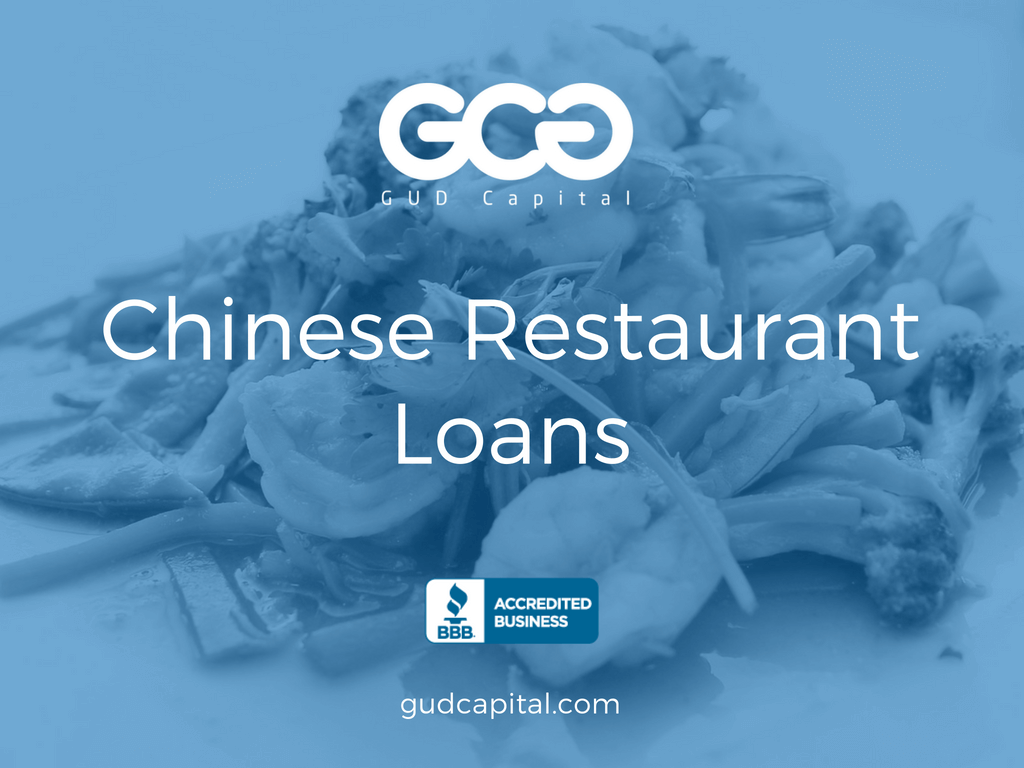Chinese Restaurant Working Capital
Chinese food has become the most sought-after ethnic food in the United States beating out Italian, Mexican, Greek, Japanese/Sushi, French, Thai, and Indian food establishments. With 45,000 Chinese restaurants across the United States—a number greater than all the KFC’s, McDonald’s, Pizza Huts, and Taco bells combined; it continues to be a thriving business that is not slowing down. Americans take from Cantonese cuisine, one of the eight culinary traditions of Chinese cooking that is highly desired in its home country as well. So to understand its allure and what puts Chinese cuisine in such high demand, we must grasp how the states have developed Chinese restaurants by altering and perfecting Asian dishes by incorporating taste and portions Americans are in favor of eating. By doing so, owners and individuals interested in these establishments as a means of business should be aware of what is working and why to thrive and create your edge in the industry.
Quick-jump to the following sections:
- Bank Loans
- Bank Line of Credit
- Unsecured Line of Credit
- SBA Loans
- Alternative Loans
- Equipment Leasing
- ACH Advance
- MCA Split
Thus many of the food items offered in American Chinese cuisine are modified versions or do not exist at all. Such as the popular item known as cream cheese wontons that most Americans presume is a part of Chinese culture. Surprisingly, it is not; dairy products are seldom used in Chinese food considering most East Asians are lactose-intolerant. There is yak cheese (smell and flavor similar to cheddar cheese produced by the domesticated wild ox) in China, but it usually appears in places like Tibet. Additionally, inner Mongolia has some traditional dishes that use milk, but by and large, dairy is not consumed en masse. When we look at many of the recipes created in American kitchens that are now familiar, they were designed using available ingredients since chefs did not have much else at their disposal. These substitutions occurred mostly in the greens category. Broccoli was swapped for kailan; carrots, peas, and white button mushrooms were put in place of mustard greens or shiitakes. The other adaptations were geared towards explicitly appealing to an American palate, meaning more recipes with sweet flavors, fried, and the number one choice of meat: chicken leading to the difference in meats used in American Chinese restaurants compared to traditional Chinese cuisine. Americans lean towards white boneless meat, whereas Chinese are more partial to dark meat and jelly textures.
However, the merging of cuisines is not the only reason why Chinese food has become a stable in the U.S. One other reason for Americans growing interest, knowledge, and excitement is because American’s are traveling to China increasing numbers each year. They are trying more exotic dishes than the Cashew Chicken, Beef and Broccoli, and sweet and Sour Pork. Another trend or more of a staple in Chinese American establishments are celebrations of individual flavors and techniques known as the Eight Great Traditions:
- Anhui, which features dishes cooked in a brown sauce such as deep-fried meatballs in plum sauce.
- Cantonese, famous for its meat roasting and grilling and fried rice.
- Fujian, specializing in soups and seafood, and dishes marinated in wine to name a few.
Another emerging trend is the interest in healthier options and recipes as Americans, and Chinese people know, its cuisine can often be high in fats and contain many fried foods. Instead of consumers viewing take-out as something of a guilty pleasure, owners are trying to move away from that notion.
To continue, Chinese restaurant owners are working to make it known that there are plenty of options that are relatively healthy and lean by most standards. For example, Chinese cuisine treats vegetables as meals rather than add-ons, as in the case in many western cuisines. Creating some culinary opportunities for those interested in cooking healthier food for their customers. Owners are opting for informing customers about steamed vegetables and rice to the fried versions that often are purchased more. Within this trend, more and more customers are figuring out ways to order smarter for when they want to have something a bit healthier than their traditional take-out. They are asking for more veggies, lean beef, and chicken to cut the carbs as much as possible and are requesting the sauces be put on the side. In general, consumers are making an effort to make healthier choices, and the American Chinese restaurant business is no exception.
With all the developments in taste, and modified versions of traditional dishes, along with more health-conscious patrons and trends, it is no surprise Chinese restaurants continue to generate well over $2 billion annually in the United States. The industry, like most, is dominated by specific brands that are leading the pact and influence the market. These would include Panda Express, PF Changs, and Pick Up Six. This business comprises both quick-service and full-service Chinese restaurants, and it is known to require minimal startup capital with no specific licensing requirements. Although, it does have a high level of competition and market saturation that can be challenging but not discouraging to future entrepreneurs.

Types of Chinese Restaurant Loans
There are plenty of funding options for restaurants, including Chinese food restaurants. The most common conventional options are bank loans, SBA loans, loans from Credit Unions and community non-profit lenders, along with alternative funding options including equipment leasing, non-bank alternative loans and cash advances. Uses for restaurant financing include purchasing businesses, refinancing and consolidating debt, hiring employees and making payroll, inventory as well as general operating capital purposes. Below we’ll take a look at the most common types of funding options available to Chinese restaurants.
Chinese Restaurant Bank Loans
Bank loans are the preferred form of financing for Chinese food restaurants seeking the best rate business financing with the longest terms and lowest fees of all commercial financing options. Bank loans are the perfect financing tool for Chinese restaurants looking to purchase their restaurant, refinance and consolidate restaurant business debt, purchasing equipment, making upgrades as well as general working capital purposes.
| Rates | 5-15% |
|---|---|
| Terms | 1-30 years |
| Funding Amounts | $50,000-$5,000,000 |
| Collateral | Required |
| Fees | Medium costs |
Bank Line of Credit
Bank lines of credit are a low-cost form of preapproved financing that allows the Chinese food restaurant owner to access cash whenever they need it to pay for uses in their restaurant. With a bank line of credit, you won’t need to apply for financing each time you’d like to draw, instead you will access the cash as needed, whenever you need it, without seeking further approval from the bank.
| Rates | 6-15% |
|---|---|
| Terms | 1-2 years |
| Funding Amounts | $10,000-$500,000 |
| Collateral | Required |
| Fees | Medium costs |
Unsecured Line of Credit
An unsecured line of credit for Chinese food restaurants usually comes in the form of business credit cards. To get approved for a business line of credit or business credit cards, you’ll need to have good personal credit (680 or above) and not have maxed-out your personal credit cards. So if you have good credit this could be an ideal way to obtain restaurant working capital.
| Rates | 0% for 12 months |
|---|---|
| Terms | 1-2 years |
| Funding Amounts | $10,000-$500,000 |
| Collateral | Not be Required |
| Fees | Medium costs |
SBA Chinese Restaurant Loans
SBA Chinese restaurant lending is another type of conventional financing that comes in the form of a term loan or line of credit provided by a bank, credit union or community lender. SBA loans aren’t actually provided by the Small Business Administration itself, instead the loans are provided by the conventional lender, and the government agrees to cover a good portion of the lender’s losses should the Chinese food restaurant fail to repay the loan.
| Rates | 5-8% |
|---|---|
| Terms | 3-25 years |
| Funding Amounts | $50,000-$5,000,000 |
| Collateral | Required |
| Fees | Medium costs |
Chinese Food Restaurant Equipment Leasing
There are multiple ways for a Chinese restaurant to obtain financing for their restaurant’s equipment. While many restaurant owners may prefer to pay for the restaurant equipment out-of-pocket, or to obtain a loan to get the equipment, another option could be to lease your Chinese restaurant equipment. Equipment leasing allows restaurant owners to obtain equipment quickly without having to pay the full-cost of the equipment upfront. After the leasing period is over, the restaurant can either extend the term, or return the equipment to the equipment leasing company.
| Rates | 8-20% |
|---|---|
| Terms | 1-10 years |
| Funding Amounts | $10,000-$5,000,000 |
| Collateral | Required |
| Fees | Medium costs |
Alternative Chinese Restaurant Loans
Non-bank alternative business loans are a way for Chinese food restaurants that have been unable to get approved for a bank loan, to obtain affordable financing. Additionally, alternative business loans require much less documentation than bank and SBA loans, and can fund in a fraction of the time – often funding within a week or less.
| Rates | 8-25% |
|---|---|
| Terms | 1-5 years |
| Funding Amounts | $10,000-$500,000 |
| Collateral | Not required |
| Fees | Medium costs |
ACH Cash Advance
Cash advances involve the sale of a Chinese restaurants future earning in exchange for upfront, lump-sum financing. Since this process involves selling portions of the Chinese restaurant’s future receivables, its technically not a business loan, but a business-to-business transaction. After the funding is complete, the restaurant will then begin repaying the loans by having a set amount sent from the restaurant’s business bank account to the funding company each day using Automated Clearing House.
| Factor rates | 1.10 – 1.50 |
|---|---|
| Terms | 3-24 months |
| Funding Amounts | $5,000-$2,000,000 |
| Collateral | Not required |
| Fees | Low to High costs |
Merchant Cash Advance Split
A merchant cash advance split is almost identical to an ACH cash advance in that they are both the sale of the Chinese restaurant’s future receivables. The main difference between the two is how the repayment to the funding company is made between these types of restaurant cash advances. As we mentioned, with an ACH advance, repayment is made by having a set amount ACHed to the funder each business day. With Chinese restaurant MCA split funding, the restaurant makes repayment by splitting a portion of their merchant credit card sales with the funder.
| Rates | 1.10 – 1.50 |
|---|---|
| Terms | 3-18 months |
| Funding Amounts | $10,000-$500,000 |
| Collateral | Not required |
| Fees | Medium costs |
Summary
As you can see there are no shortages of funding options for Chinese food restaurants – but the key is making sure that you obtain the right restaurant loan to take care of your current needs, with the lowest cost of borrowing possible. If you would like to explore financing options for your Chinese food or take-out restaurant, and need help understanding your options, please reach-out to our funding specialists, and we’ll help you navigate the process.





















